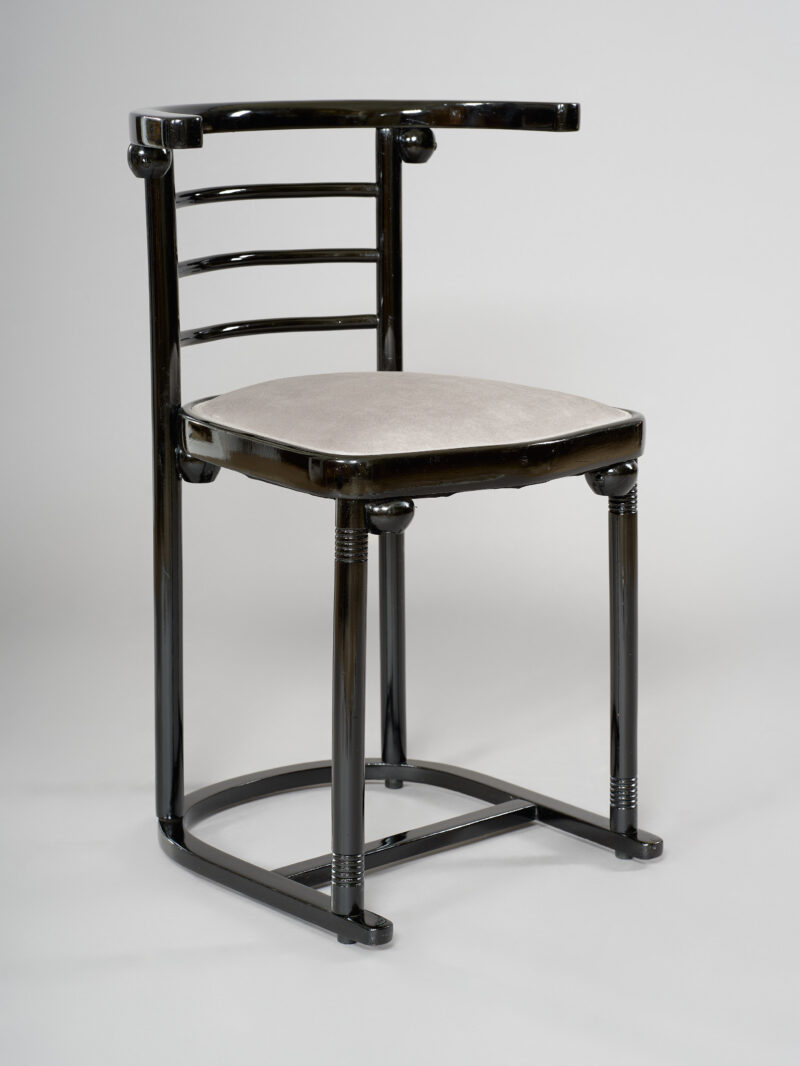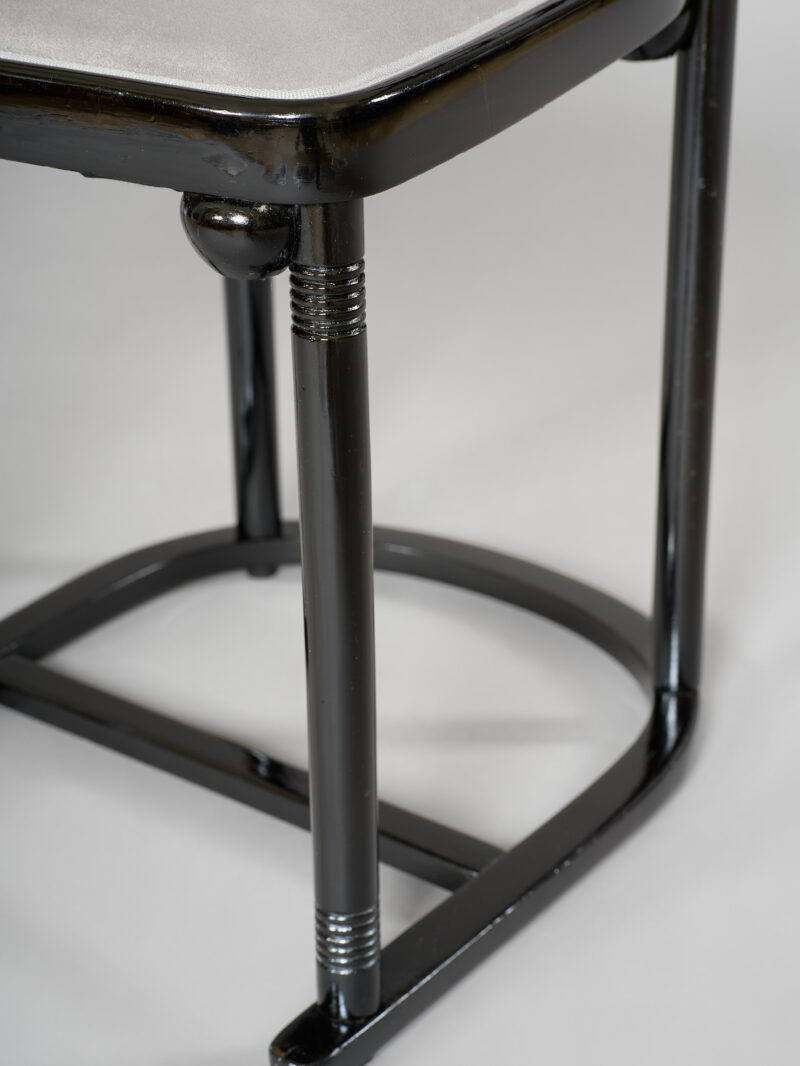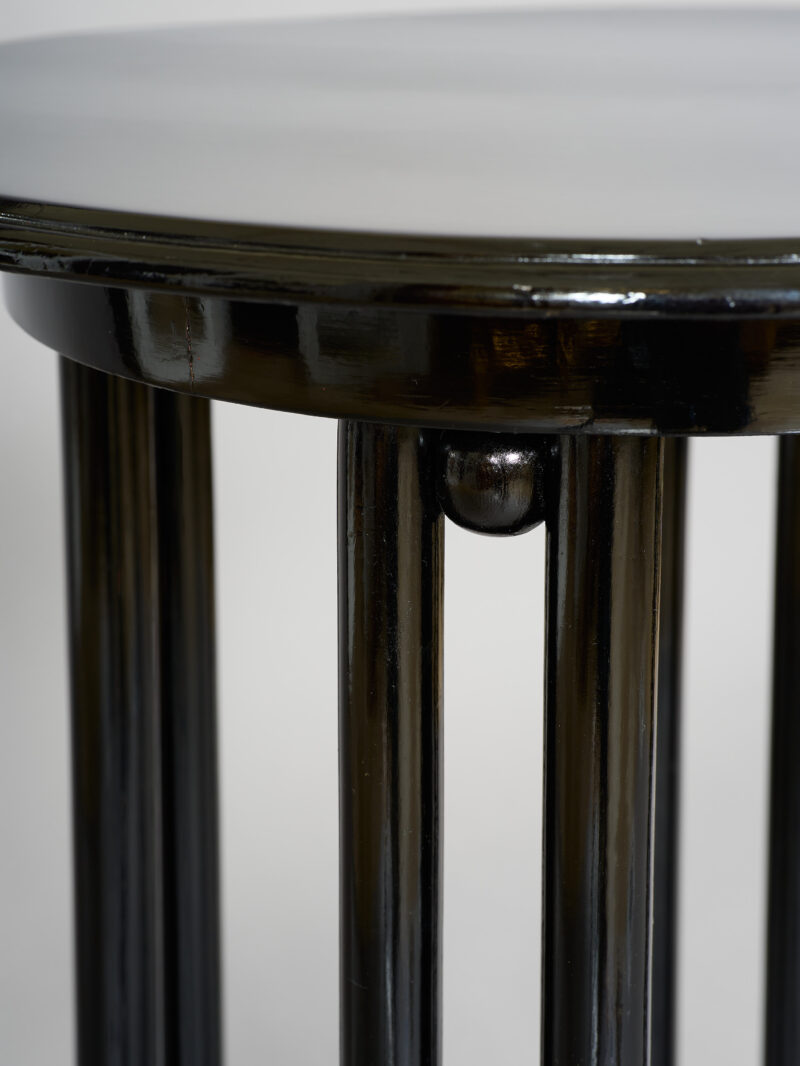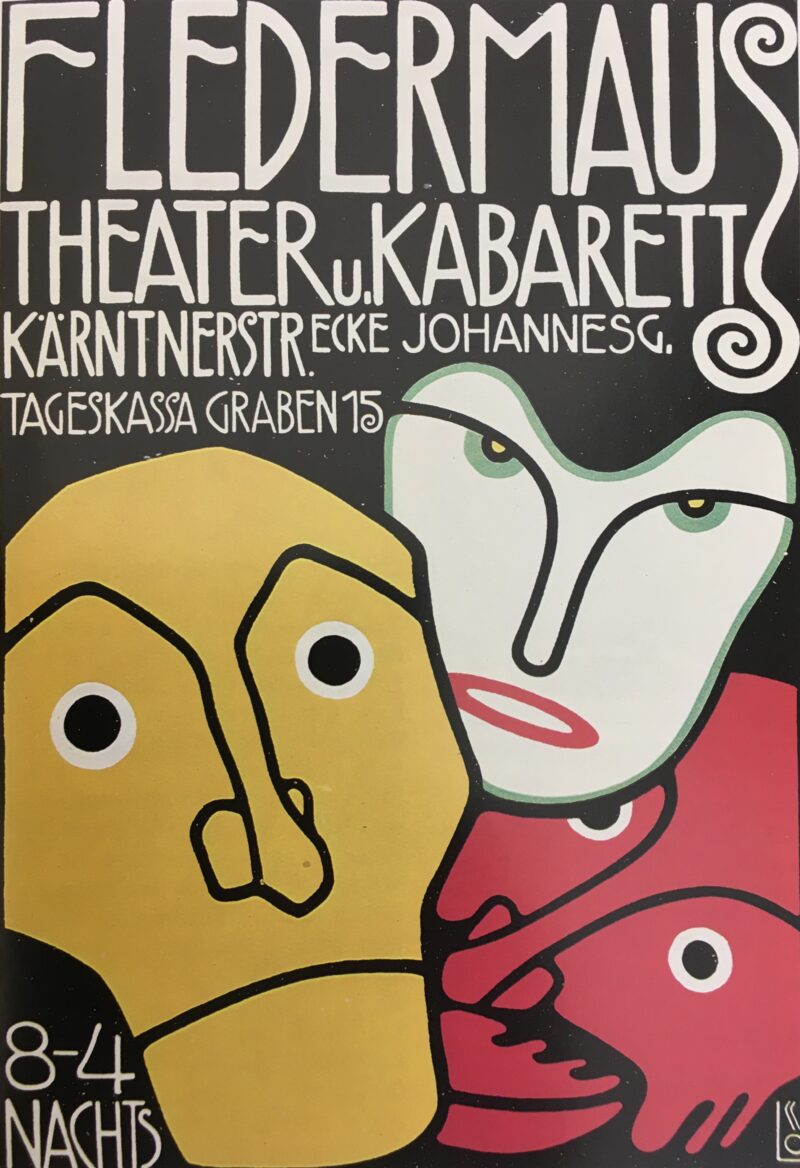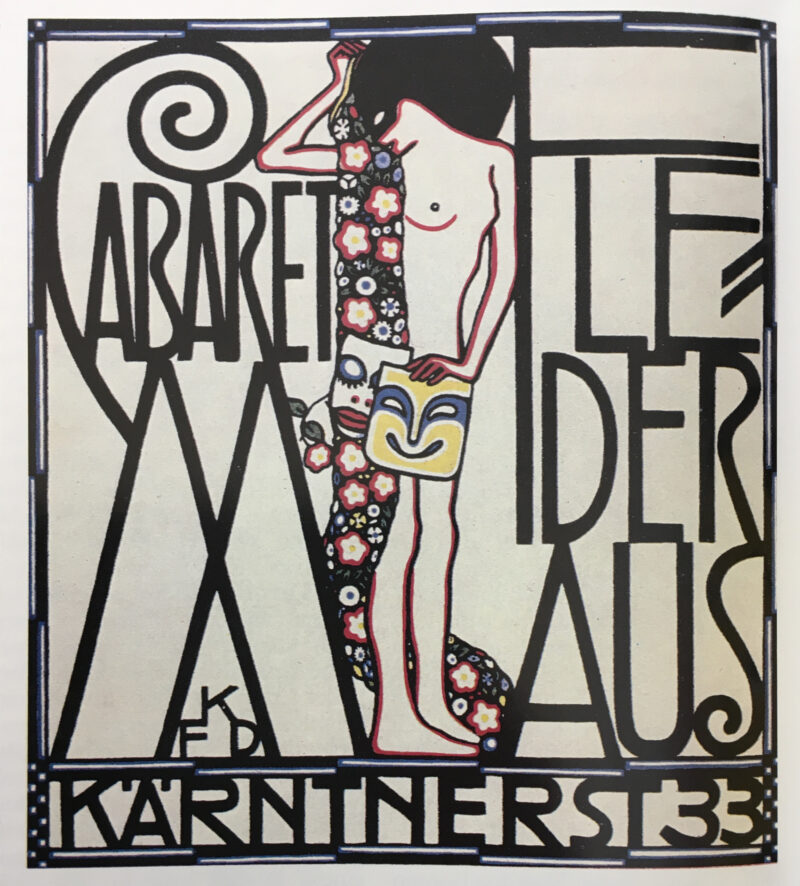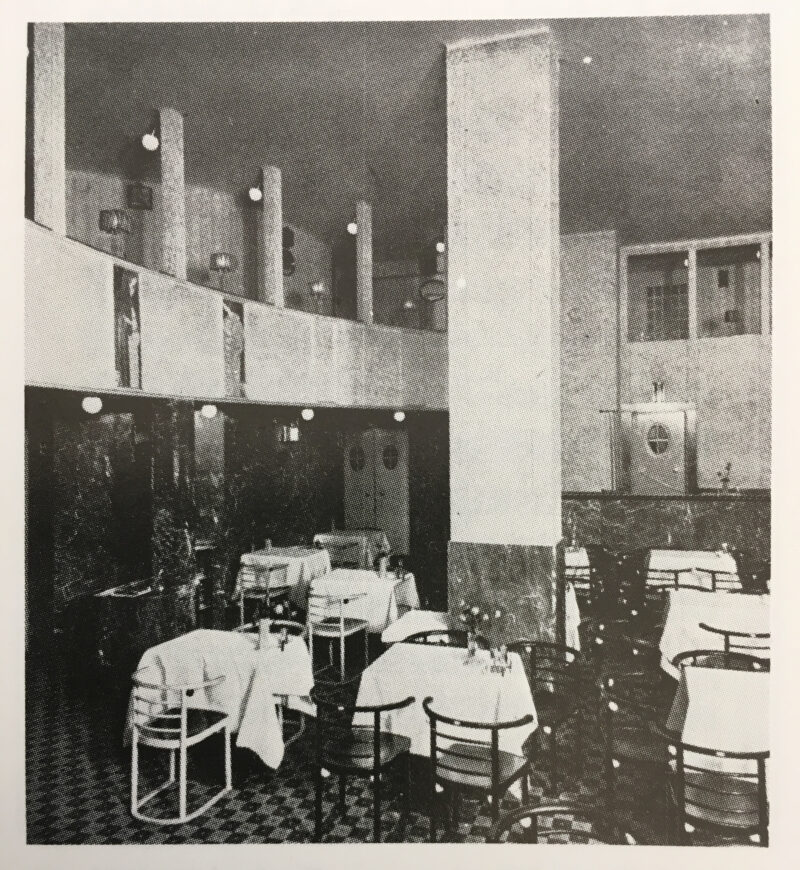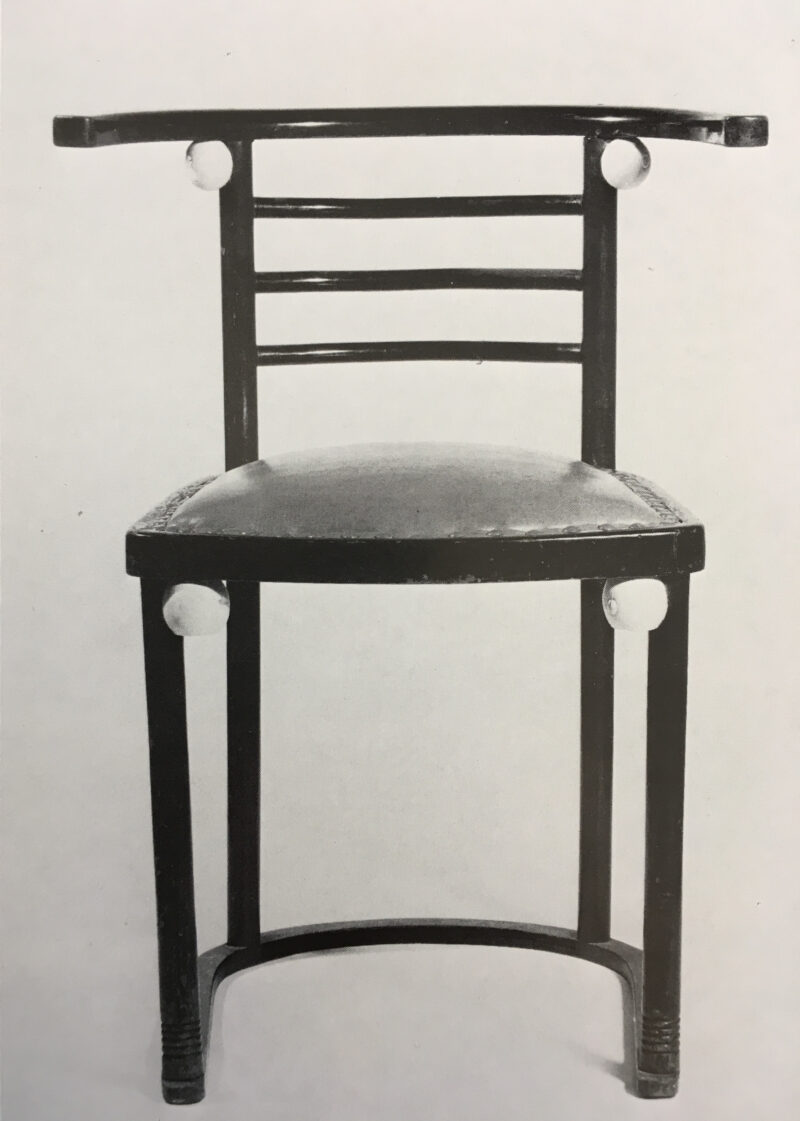
Small Salon Seating Group of aristocratic provenance, designed by Josef Hoffmann.
The so-called “Fledermaus Gruppe”, named after the cabaret “Fledermaus” (“Bat”) in Vienna (see reference images of the cabaret below). The seating group, polished in black shellac, consists of four chairs, the so-called “Fledermaus” armchair (by Kohn Mod. No. 728), and a round table, all executed in beech and bent beechwood. The small seating group has been newly upholstered and covered in Alcantara.
Provenance:
Court lady to Empress Elisabeth Marie Countess Festetics de Tolna. Mária Festetics, born on October 20, 1839, in Tolna, Tolna County, Hungary; Died on April 17, 1923, in Söjtör, Zala County, Hungary.
After much hesitation, Marie Festetics was appointed court lady to the Empress in 1871 at the urging of Count Andrássy and Ferenc Deák von Kehida. Having heard rumors about the difficult Empress, she feared she would no longer be able to lead her own life, but she soon found favor with Elisabeth and remained as her court lady until her death. Since Elisabeth did not want to do without her, Marie had to reject countless marriage proposals at the Empress’s request, and when Marie once seriously fell in love with a Russian prince, Elisabeth forbade her to accept his proposal.
Marie quickly became one of the Empress’s closest confidantes, perhaps one could say her friend, for whom she, as well as for her homeland Hungary, abandoned her family plans. Countess Festetics was considered an exceptionally beautiful and particularly intelligent woman at the Austrian court. Her foresight, insight into human nature, and keen observational skills were praised and admired in many quarters.
One of the significant historical documents of this time at the Austrian court is the diary of Countess Festetics, in which she meticulously recorded all events and often depicted them unadorned.
It is a valuable historical source that not only details life at the Habsburg court but also describes the life of the Empress in detail. The Festetics diary is now housed in the Széchényi National Library in Budapest…
Elisabeth’s biographer Corti particularly emphasized Marie Festetics’ extraordinary insight into human nature, which is evident in her writings. Corti: “It is remarkable how this woman always senses in advance which personalities will later have an unfortunate influence on her mistress. The Countess records her concerns on the same day that these personalities enter the Empress’s life in her diary; so it is not a retrospective judgment but shows that this woman has a correct instinct, an enormously sharp observation, and outstanding mental capacities. While Mrs. von Ferenczy is unlimitedly faithful, modest, and devoted, Countess Festetics is undoubtedly the most intellectually advanced and sharpest woman in the circle gradually assembled around Elisabeth.”
Brigitte Hamann underscores the devotion of the lady-in-waiting to her Empress. In the Festetics diary, there are rhapsodic entries such as (1872): “She is the embodiment of the concept of loveliness. Sometimes I think she is a lily, then again: a swan, a fairy, or an elf.”
Marie Festetics was exceptionally loyal in her diary entries — occasionally, she expressed outrage over gossip stories without including their content in her diary and remarked, for example: “I would never forgive myself for preserving such a story from oblivion! Terrible!” Despite all the admiration and loyalty, Marie Festetics often criticized the Empress’s behavior sharply and noted in 1873, for example: “She is an enthusiast, and her main occupation is brooding. […] She needed an occupation, and since the only one she could have is contrary to her nature, everything lies dormant within her.” Corti: “The Countess never tires of putting herself in her mistress’s shoes.”
Over the years, Marie (alongside Ida von Ferenczy, who held the title of ‘Empress’s Reader’) became Elisabeth’s most popular court lady and constant companion. The work as a court lady, who Elisabeth had to accompany on her numerous travels and hikes, became too exhausting for Marie Festetics over the years. “I am dead tired,” she wrote in her diary in 1882 after a long hike. Therefore, in January 1883, Charlotte von Majlath was appointed court lady and companion to the Empress at the Viennese court. In 1890, another Hungarian, the 24-year-old Countess Janka Mikes, was appointed court lady, who seemed better suited to the Empress’s high sporting ambitions. She was followed in 1894 by Irma Sztáray as court lady and companion on the Empress’s hikes. Marie Festetics, along with Ida von Ferenczy, was transferred to the “indoor service.”
Marie Festetics was distraught after the Empress’s assassination and wrote to Ida Ferenczy: “We will mourn a lot together, Ida, the best belonged to us. No one will rob us of that, it is a jewel — we always loved her, not like many who only realized it when the dagger pierced her heart.”
After the Empress’s death, Marie Festetics had to vacate her apartment in the Hofburg. She moved to an apartment in the third district of Vienna, which she had bought earlier. Ida von Ferenczy, who suffered the same fate, lived in a neighboring apartment. After the Empress’s death, Marie Festetics spent a lot of time on her estate in Söjtör, went on trips, visited many places that she once visited with Elisabeth. She usually spent the winters in Vienna, in her apartment on Reisnerstraße. There she visited Emperor Franz Joseph annually shortly after New Year’s Day. She sold her Vienna apartment shortly before her death, which occurred in Söjtör.
Literature / Quotes:
• Gudula Walterskirchen, Beatrix Meyer (eds.): “The Diary of Countess Marie Festetics. Empress Elisabeth’s Most Intimate Friend.” Residenz-Verl. St. Pölten 2014
• Katalin Béres, Beatrix Meyer: “My beloved quiet Söjtör. Festetics Mária court lady and family.” Söjtör 2014, (Hungarian)
• Egon Caesar Conte Corti: “Elisabeth, the Strange Woman. According to the written legacy of the Empress, the diaries of her daughter, and other unpublished diaries and documents.” Pustet, Salzburg, and others, 1934
• Brigitte Hamann: “Elisabeth. Empress against her will.” Revised new edition, paperback edition, 10th edition. Piper, Munich, and others 2008, (Piper series 2990)
• Beatrix Meyer, “Empress Elisabeth and her Hungary.” Allitera, Munich 2019
• From the diary of a lady-in-waiting (“From the diary of a lady-in-waiting”), diary entries of Maria Festetics from Gödöllő and Budapest; Compiled by Maria Kiss-Tolnayné, Gödöllő 200
Please click HERE for another salon seating group by Josef Hoffmann in our collection, which is also named after the cabaret ‘Fledermaus’ in Vienna. It consists of a bench, two armchairs, and four chairs.
